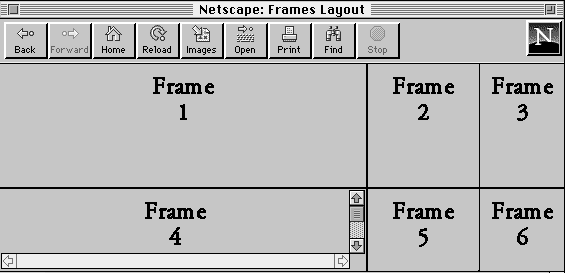Frames let you divide its main display window into independent window partitions -- frames, each simultaneously displaying a different document--something like a wall of monitors in a TV control room.

The above figure is a simple example of a Netscape frame display. It shows how the document window may be divided into columns and rows of individual frames separated by rules and scroll bars. Although it is not immediately apparent in the example, each frame in the window is displaying an independent document--HTML ones in this case--but the individual documents may be any valid content the browser is capable of displaying, including multimedia. If the frame's contents include a hypertext link the user selects, the new document's contents, even another frame document, may replace that same frame, another frame's content, or the entire browser window.
You enable Netscape frames with a special frame document. Its contents do not get displayed. Rather, the frame document contains extension HTML tags that tell the browser how to divide its main display window into discrete frames, and what documents go inside the frames.
The individual documents referenced and displayed in the frame document window act independently, to a degree; the frame document controls the entire window. So, for instance, the browser's ``Back'' and ``Forward'' buttons don't work for an individual frame, but links the entire frame document with others you viewed previously.
You can, however, direct one frame's document to load new content into another frame. That's done by attaching a name to a frame and targeting the named frame with a special attribute for the hypertext link a tag.